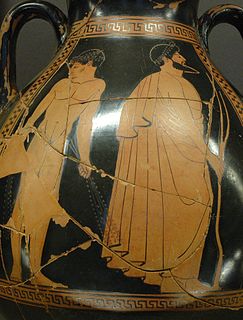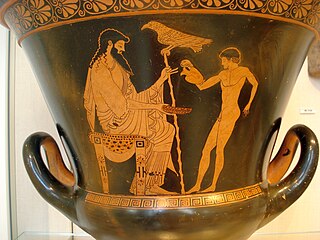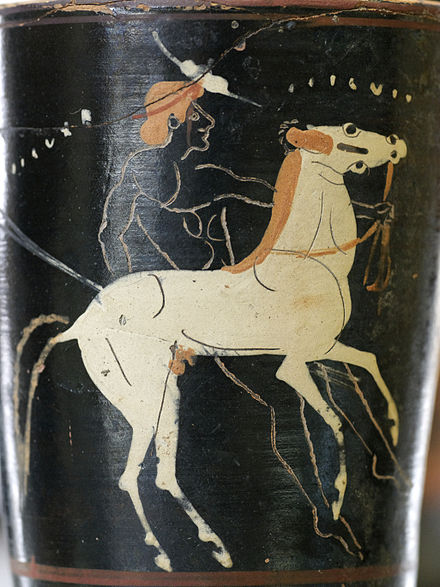
Ancient Greek pottery, due to its relative durability, comprises a large part of the archaeological record of ancient Greece, and since there is so much of it, it has exerted a disproportionately large influence on our understanding of Greek society. The shards of pots discarded or buried in the 1st millennium BC are still the best guide available to understand the customary life and mind of the ancient Greeks. There were several vessels produced locally for everyday and kitchen use, yet finer pottery from regions such as Attica was imported by other civilizations throughout the Mediterranean, such as the Etruscans in Italy. There were various specific regional varieties, such as the South Italian ancient Greek pottery.

Exekias was an ancient Greek vase-painter and potter who was active in Athens between roughly 545 BC and 530 BC. Exekias worked mainly in the black-figure technique, which involved the painting of scenes using a clay slip that fired to black, with details created through incision. Exekias is regarded by art historians as an artistic visionary whose masterful use of incision and psychologically sensitive compositions mark him as one of the greatest of all Attic vase painters. The Andokides painter and the Lysippides Painter are thought to have been students of Exekias.

Red-figure vase painting is one of the most important styles of figural Greek vase painting.

The Kleophrades Painter is the name given to the anonymous red-figure Athenian vase painter, who was active from approximately 510 – 470 BCE and whose work, considered amongst the finest of the red figure style, is identified by its stylistic traits.

Nikosthenes was a potter of Greek black- and red-figure pottery in the time window 550-510 BC. He signed as the potter on over 120 black-figure vases, but only 9 red-figure. Most of his vases were painted by someone else, called Painter N. Beazley considers the painting "slovenly and dissolute;" that is, not of high quality. In addition, he is thought to have worked with the painters Anakles, Oltos, Lydos and Epiktetos. Six's technique is believed to have been invented in Nikosthenes' workshop, possibly by Nikosthenes himself, around 530 BC. He is considered transitional between black-figure and red-figure pottery.

The Antimenes Painter was an Attic vase painter of the black-figure style, active between circa 530 and 510 BC.

Psiax was an Attic vase painter of the transitional period between the black-figure and red-figure styles. His works date to circa 525 to 505 BC and comprise about 60 surviving vases, two of which bear his signature. Initially he was allocated the name Menon Painter by John Beazley. Only later was it realised that the artist was identical with the painters signing as Psiax.

The Amasis Painter was an ancient Greek vase painter who worked in the black-figure technique. He owes his name to the signature of the potter Amasis, who signed 12 works painted by the same hand. At the time of the exhibition, "The Amasis Painter and His World" (1985), 132 vases had been attributed to this artist.

The Andokides Painter was an ancient Athenian vase painter, active from approximately 530 to 515 B.C. His work is unsigned and his true name unknown. He was identified as a unique artistic personality through stylistic traits found in common among several paintings. This corpus was then attributed by John D. Beazley to the Andokides Painter, a name derived from the potter Andokides, whose signature appears on several of the vases bearing the painter's work. He is often credited with being the originator of the red-figure vase painting technique. To be sure, he is certainly one of the earliest painters to work in the style. In total, fourteen amphorae and two cups are attributed to his hand. Six of the amphorae are "bilingual", meaning they display both red-figure and black-figure scenes.

The Pan Painter was an ancient Greek vase-painter of the Attic red-figure style, probably active c. 480 to 450 BCE. John Beazley attributed over 150 vases to his hand in 1912:
"Cunning composition; rapid motion; quick deft draughtsmanship; strong and peculiar stylisation; a deliberate archaism, retaining old forms, but refining, refreshing, and galvanizing them; nothing noble or majestic, but grace, humour, vivacity, originality, and dramatic force: these are the qualities which mark the Boston krater, and which characterize the anonymous artist who, for the sake of convenience, may be called the 'master of the Boston Pan-vase', or, more briefly, 'the Pan-master'."

Eucharides Painter is the common nickname of an ancient Greek artist who decorated but did not sign attic vases. Neither his real name, nor the dates of his birth and death are known. Presumably this artist was a pupil of the Nikoxenos Painter.

The Athena Painter was an Attic black-figure vase painter, active about 490 to 460 BC. His speciality were white-ground lekythoi painted in the black-figure style.
The Lysippides Painter worked in Athens in the second half of the 6th century BC. He was a black-figure painter of a classic style. He most probably trained with Exekias in his workshop until moving to the Andokides workshop where he mainly painted large, expensive vases and did some work on bilingual vases with Andokides P being the red-figure painter. He was named, after much debate ensuring he was not the Andokides Painter using red-figure, after a Kalos found on one of his vases.

The Painter of Berlin A 34 was a vase painter during the pioneering period of Attic black-figure vase painting. His real name is unknown, his conventional name derived from his name vase in the Antikensamlung Berlin. He is the first individual vase painter of the style in Athens recognised by scholarship. His works are dated to circa 630 BC. Two of his vases were discovered in Aegina. Since the 19th century, those pieces were on display in Berlin, but they disappeared or were destroyed during the Second World War.

The Little masters were a group of potters and vase painters who produced vases of the Attic black-figure style featuring well-done figures in miniature. They were active in Athens approximately 560 — 530 BC. They mainly produced Little-master cups: lip cups, band cups and droop cups, but were not entirely limited to such shapes. The group includes:

The Leagros Group was a group of Attic black-figure vase painters active during the last two decades of the 6th century BC. The name given to the group by modern scholars is a conventional one, derived from a series of name vases.

The Rycroft Painter was an Attic late black-figure vase painter, active in the final decade of the sixth century BC. His real name is not known.

The Madrid Painter was an Attic black-figure vase painter active during the late period of the style, around 520 BC.

The Lysippides Painter was an Attic vase painter in the black-figure style. He was active around 530 to 510 BC. His real name is not known.

Sappho Painter was an Attic black-figure vase painter, active c. 510–490 BCE.



















